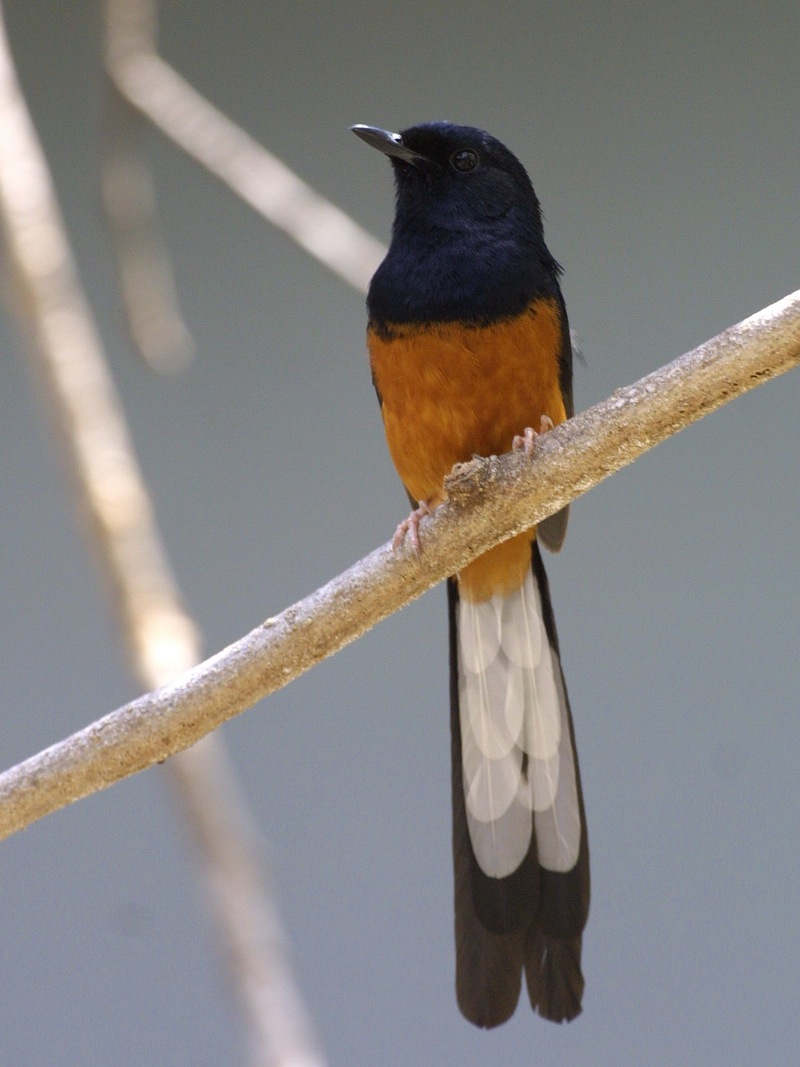|
| 질의: Glossy-black thrush | 결과: 4번째/5 | |
White-rumped Shama (Copsychus malabaricus) - Wiki
| 제목: | White-rumped Shama (Copsychus malabaricus) - Wiki
| |

| 해상도: 1200x1600
파일크기: 543615 Bytes
촬영일: 2002:03:23 12:15:13
사진기: Canon EOS D30 (Canon)
F number: f/8.0
Exposure: 1/90 sec
Focal Length: 400/1
등록시간: 2007:10:25 22:57:55
|
White-rumped Shama
From Wikipedia, the free encyclopedia
[Photo] White-rumped Shama (Copsychus malabaricus) male. Date 23 March 2002. Photograph by K. W. Bridges. Source: http://www.botany.hawaii.edu/Biology101/lab/Lab01/birds/campus_birds.htm License: public domain.
The White-rumped Shama (Copsychus malabaricus) is a small passerine bird of the family Muscicapidae. It was formerly classified as a member of the Thrush family, Turdidae, causing it to be commonly known as the White-rumped Shama Thrush or simply Shama Thrush.
Distribution
They are native to South Asia, but were introduced to Kaua'i, Hawai'i, in early 1931 from Malaysia, and to O'ahu in 1940. They are common in valley forests or on the ridges of the southern Ko'olaus, and tend to nest in undergrown or low trees of lowland broadleaf forests.
Physical Characteristics
They typically weigh between 1 and 1.2 ounces and are around 9 to 11 inches in length. Males are glossy black with a chestnut belly and white feathers on the rump and outer tail. Females are more grayish-brown, and are typically shorter than males. Both sexes have a black bill and pink feet. Juveniles have a more grayish or brownish coloration, similar to that of the females, with a blotchy or spotted chest.
Behavior
White-rumped Shama are shy, but very territorial. The territories include a male and female during the breeding season with the males defending the territory, but each sex may have different territories when they are not breeding.
The voice of this species is rich and melodious. It is loud and clear, with a variety of phrases, and often mimics other birds. They also make a clicking ('Tck') sound with their wings when they are in distress or flying over open areas.
Breeding
During courtship, males pursue the female, alight above the female, give a shrill call, and then flick and fan out their tail feathers. It is followed by a rising and falling flight pattern by both sexes. It the male is unsuccessful, the female will threaten the male, gesturing with the mouth open.
Parental behavior includes both sexes participating. The nests are mainly comprised of roots, leaves, ferns, and stems, and incubation lasts between 12 and 15 days. The eggs are white to light aqua, with variable shades of brown blotching, and are approximately 0.7 by 0.9 inches.
http://en.wikipedia.org/wiki/White-rumped_Shama
| The text in this page is based on the copyrighted Wikipedia article shown in above URL. It is used under the GNU Free Documentation License. You may redistribute it, verbatim or modified, providing that you comply with the terms of the GFDL. |
|
댓글 |
|---|
| | 손님 |
|
Copsychus malabaricus (White-rumped Shama)
Copsychus malabaricus is a passerine bird native to south and south-east Asia. Its popularity as a cage bird has caused significant population declines in parts of its native range, but international trade has resulted in the establishment (since the 1980s) of a feral population in Taiwan, where it is of concern as a possible invasive species. It was introduced in the 1930s to Hawaii, where there is concern that the well-established population may negatively affect native bird species. However there is no evidence confirming any significant negative effects in either Taiwan or Hawaii. |
^o^
동물그림창고 똑똑전화 누리집
^o^
|
|
|

